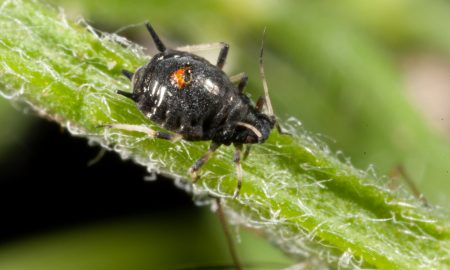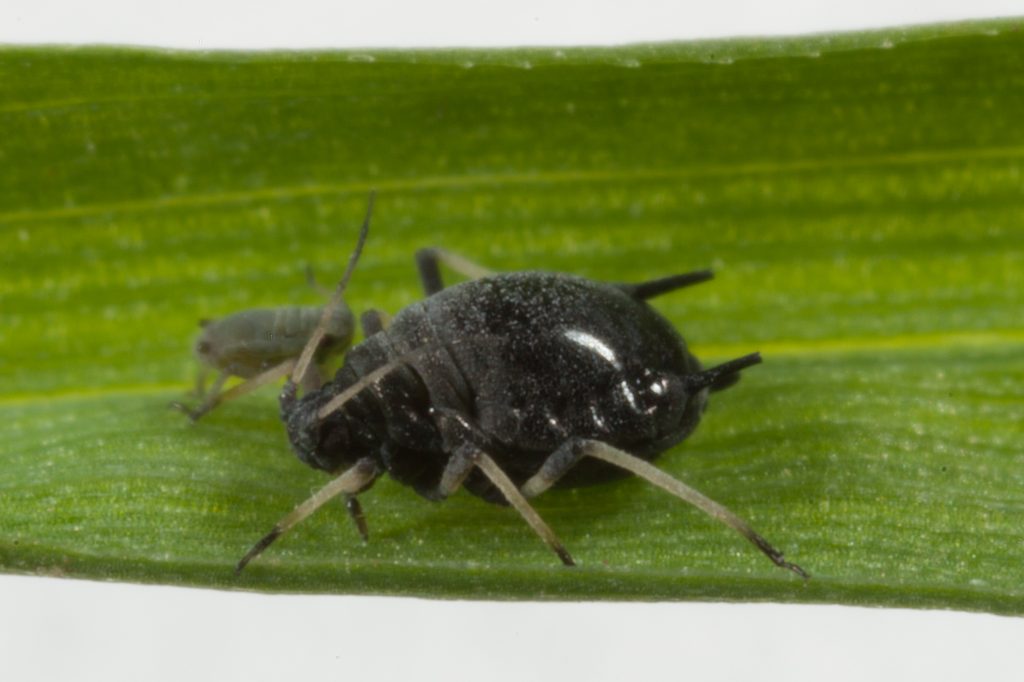Cowpea aphid
Aphis craccivora

Photo by Andrew Weeks, Cesar Australia
Summary Top
Cowpea aphids are shiny black with white and black legs. This species is found in medics, vetch and a wide range of summer and winter pulse crops throughout Australia. In autumn, the aphids appear to be able to move large distances to colonise establishing crops and pastures. Cowpea aphids are known to transmit several plant viruses that can contribute to yield losses, including cucumber mosaic virus, bean yellow mosaic virus, alfalfa mosaic virus and pea seed-borne mosaic virus.
Occurrence Top
The cowpea aphid is a widespread and relatively common pest of legume crops throughout Australia. They have a wide range of host plants and can tolerate warm, dry weather conditions that cause many other aphid species to suffer.
Cowpea aphids are commonly found on legumes and pulses including field peas, lupins, lentils, faba beans, lucerne, clover and medics.
Description Top
Aphids are a group of soft-bodied bugs commonly found in a wide range of crops and pastures. Identification of crop aphids is very important when making control decisions. Distinguishing between aphids can be easy in the non-winged form but challenging with winged aphids.
Adult cowpea aphids are shiny black in colour and nymphs are dull grey. All stages have white and black legs. Nymphs are lightly dusted with wax. When fully grown adults are approximately 2 mm long.


Lifecycle Top
Winged aphids fly into crops from legume and non-legume hosts, and colonies of aphids start to build up within the crop. Aphids can reproduce both asexually and sexually however in Australia, the sexual phase is often lost.

Behaviour Top
Cowpea aphids are capable of being transported (migrating on the wind) large distances from more favourable hosts, particularly during autumn. They tend to colonise single plants before moving onto surrounding plants to form groups of plants in ‘hot spots’ within a crop.
Similar to Top
Other aphids
Crops attacked Top
Commonly found on faba beans, lentils, medics, lucerne, clover, vetch and lupins.
Damage Top
Direct feeding damage:
Aphids can cause direct feeding damage to plants when in large numbers as they remove sap, which can cause wilting of plants. Cowpea aphids also inject toxins into the plant while feeding. Cowpea aphids form dense colonies on individual plants, with infestations usually starting on the growing tips and spreading down the stem. Initial signs of damage include yellowing or whitening of leaf veins, with heavy colonisation causing rapid wilting of leaves and eventually plant death. Other symptoms include leaf bunching and stem twisting. Secretion of honeydew by aphids can cause secondary fungal growth, which inhibits photosynthesis and can decrease plant growth.
In pulse crops, aphid feeding damage (in the absence of virus infection) can result in yield losses of up to 90% in susceptible varieties, and up to 30% in varieties with intermediate resistance.
Indirect damage:
In addition to affecting crops through direct feeding, cowpea aphids are believed to be responsible for photosensitisation (inflammation of the skin & eyes) when infected pastures are grazed by livestock. Photosensitisation is thought to occur as a result of photodynamic fluorescent pigments in the aphid, but the exact cause is unknown. If you are concerned about photosensitisation of livestock feeding on crops and pastures infested with cowpea aphid, seek veterinary assistance for correct diagnosis and management of the condition.
Cowpea aphids also cause indirect damage by spreading plant viruses. Aphids spread viruses between plants by feeding and probing as they move between plants and paddocks. Cowpea aphids transmit important viruses including cucumber mosaic virus (CMV), bean yellow mosaic virus (BYMV), alfalfa mosaic virus (AMV) and pea seed-borne mosaic virus (PsbMV). Yield losses in some pulse crops as a direct result of viruses spread by cowpea aphids can reach as high as 80%.
Cowpea aphids can cause damage by direct feeding when in high numbers and by transmitting viruses including cucumber mosaic virus, bean yellow mosaic virus, alfalfa mosaic virus and pea seed-borne mosaic virus.
Monitor Top
Cowpea aphids are most prominent in spring, but are also active during autumn and persist through winter. Regularly monitor vulnerable crops during bud formation to late flowering.
Economic thresholds Top
Winter pulses:
When determining economic thresholds for aphids, it is critical to consider several other factors before making a decision. Most importantly, the current growing conditions and moisture availability should be assessed. Crops that are not moisture stressed have a greater ability to compensate for aphid damage and will generally be able to tolerate far higher infestations than moisture stressed plants before a yield loss occurs.
Thresholds for managing aphids to prevent the incursion of aphid-vectored virus have not been established and will be much lower than any threshold to prevent yield loss via direct feeding.
In WA, it is recommended that lupin crops are sprayed when 30% of inflorescences are infested with 30 or more aphids (Berlandier 1999).
Management options Top
Biological
There are many effective natural enemies of aphids. Hoverfly larvae, lacewings, ladybird beetles and damsel bugs are known predators that can suppress populations. Aphid parasitic wasps lay eggs inside bodies of aphids and evidence of parasitism is seen as bronze-coloured enlarged aphid ‘mummies’. As mummies develop at the latter stages of wasp development inside the aphid host, it is likely that many more aphids have been parasitized than indicated by the proportion of mummies. Naturally occurring aphid fungal diseases (Pandora neoaphidis and Conidiobolyus obscurus) can also suppress aphid populations.
If the parasitism trend increases over time, there are good prospects that aphid populations will be controlled naturally.
Cultural
Control summer and autumn weeds in and around crops, particularly legumes, to reduce the availability of alternate hosts between growing seasons.
Sow crops early to enable plants to begin flowering before aphid numbers peak in spring and use a high sowing rate to achieve a dense crop canopy, which will assist in deterring aphid landings. Select cultivars that are less susceptible to aphid feeding damage.
Consider seed testing to assess the level of virus infection of seed-borne viruses (e.g. CMV) before sowing.
Chemical
The use of insecticide seed treatments can delay aphid colonisation and reduce early infestation and aphid feeding.
A border spray in autumn/early winter, when aphids begin to move into crops, may provide sufficient control without the need to spray the entire paddock. Avoid the use of broad-spectrum `insurance` sprays and apply insecticides only after monitoring and distinguishing between aphid species. Consider the populations of beneficial insects before making a decision to spray, particularly in spring when these natural enemies can play a very important role in suppressing aphid populations if left untouched.
Acknowledgements Top
This article was compiled by Paul Umina (cesar) and Sandra Hangartner.
References/Further Reading Top
Bailey PT. 2007. Pests of field crops and pastures: Identification and Control. CSIRO Publishing, Melbourne, Australia.
Bellati J, Mangano P, Umina P and Henry K. 2012. I SPY. Insects of Southern Australian Broadacre Farming Systems Identification Manual and Education Resource. Department of Primary Industries and Resources South Australia (PIRSA), the Department of Agriculture and Food Western Australia (DAFWA) and cesar Pty Ltd.
Berlandier FA. 1999. Aphids in lupin crops: Their biology and control. Farmnote 44/99. Department of Agriculture Western Australia.
Berlandier F, Severtson D and Mangano P. 2010. Aphid management in canola crops. Western Australia Department of Agriculture and Food. Farmnote 440.
Blackman RL and Eastop VF. 2000. Aphids on the world’s crops: an identification and information guide. John Wiley and Sons, England.
Bwye AM, Proudlove W, Berlandier FA and Jonew RAC. 1997. Effects of applying insecticides to control aphid vectors and cucumber mosaic virus in narrow-leafed lupins (Lupinus angustifolius). Australian Journal of Experimental Agriculture 37: 93-102.
Coutts BA and Jones RAC. 2000. Viruses infecting canola (Brassica napus) in south-west Australia: incidence, distribution, spread and infection reservoir in wild radish (Raphanus raphinistrum). Australian Journal of Agricultural Research 51: 925–936.
Edwards OR, Ridsdill-Smith TJ and Berlandier FA. 2003. Aphids do not avoid resistance in Australian lupin (Lupinus angustifolius, L. luteus) varieties. Bulletin of Entomological Research 93: 403-411.
Edwards OR, Franzmann B, Thackray D, Micic S. 2008. Insecticide resistance and implications for future aphid management in Australia grains and pastures: a review. Australian Journal of Experimental Agriculture 48: 1523-1530.
Gutierrez AP, Nix HA, Havenstein DE and Moore PA. 1974. The Ecology of Aphis craccivora Koch and Subterranean Clover Stunt Virus in South-East Australia. III. A Regional Perspective of the Phenology and Migration of the Cowpea Aphid. Journal of Applied Ecology 11: 21-35.
Hertel K, Roberts K and Bowden P. 2013. Insect and Mite control in field crops. New South Wales DPI. ISSN 1441-1773.
Jones RAC and Proudlove W. 1991. Further studies on cucumber mosaic virus infection of narrow-leafed lupin (Lupinus angustifolius): seed-borne infection, aphid transmission, spread and effects on grain yield. Annals of Applied Biology 118: 319-329.
Jones R, Coutts B, Smith L and Hawkes J. 2003. Benefits provided by treating canola seed with imidacloprid seed dressing. Agribusiness Crop Updates. Department of Agriculture, Western Australia.
Kamphuis LG, Gao L and Singh KB. 2012. Identification and characterization of resistance to cowpea aphid (Aphis craccivora Koch) in Medicago truncatula. BMC Plant Biology 12: 101.
Lawrence L. 2009. Taking the fight to aphids. Farming Ahead 215: 49 -51.
Marcroft S, Potter T and Jones R. 2011. Canola diseases: The back pocket guide. GRDC.
Moran N. 1992. The evolution of aphid life cycles. Annual Review of Entomology 37, 321-348.
Schwinghamer M and Schilg M. 2003. The virus situation in chickpeas, faba beans and canola. Proceedings GRDC Update – Dubbo.
Traicevski V and Ward SA. 2002. Probing behaviour of Aphis craccivora Koch on host plants of different nutritional quality. Ecological Entomology 27: 213-219.
Valenzuela I and Hoffmann AA. 2015. Effects of aphid feeding and associated virus injury on grain crops in Australia. Austral Entomology. DOI: 10.1111/aen.12122.
| Date | Version | Author(s) | Reviewed by |
|---|---|---|---|
| May 2015 | 1.0 | Paul Umina (cesar) and Sandra Hangartner | Alana Govender (cesar) and Bill Kimber (SARDI) |
| June 2024 | 1.1 | Paul Umina (cesar) and Sandra Hangartner | Paul Umina (cesar) and Lilia Jenkins (Cesar Australia) |
What are PestNotes?
PestNotes are information sheets developed through a collaboration between Cesar Australia and the South Australian Research and Development Institute (SARDI). Copyright: © All material published in PestNotes is copyright protected by Cesar Australia and SARDI and may not be reproduced in any form without written permission from both agencies.
Disclaimer
The material provided in PestNotes is based on the best available information at the time of publishing. No person should act on the basis of the contents of this publication without first obtaining independent, professional advice. PestNotes may identify products by proprietary or trade names to help readers identify particular products. We do not endorse or recommend the products of any manufacturer referred to. Other products may perform as well as or better than those specifically referred to. Cesar Australia and PIRSA will not be liable for any loss, damage, cost or expense incurred or arising by reason of any person using or relying on the information in this publication. Any research with unregistered pesticides or products referred to in PestNotes does not constitute a recommendation for that particular use.

